1860-1899 Death of Prince Albert
1860-1899 Death of Prince Albert is in 19th Century Events.
Death of Prince Albert
On 14 Dec 1861 Prince Albert Saxe Coburg Gotha (age 42) died at Windsor Castle [Map]. His wife, Queen Victoria of the United Kingdom (age 42) never recovered from his death spending, more or less, the remainder of her life in mourning.
Funeral of Prince Albert
On 23 Dec 1861 Prince Albert Saxe Coburg Gotha (deceased) was buried at St George's Chapel, Windsor Castle [Map].
1862 Appointment of Garter Knights
In 1862 Queen Victoria of the United Kingdom (age 42) appointed seven Knights of the Garter:
729th Charles Canning 1st Earl Canning (age 49). He died a month later.
730th Edward Adolphus Seymour 12th Duke of Somerset (age 57).
731st. John Russell 1st Earl Russell (age 69).
732nd Anthony Ashley-Cooper 7th Earl Shaftesbury (age 60).
733rd William Thomas Wentworth-Fitzwilliam 6th and 4th Earl Fitzwilliam (age 46).
734th Prince Louis Hesse Darmstadt IV Grand Duke (age 24).
735th Grand Duke Frederick William of Mecklenburg-Strelitz (age 42).
1862 Battle of Middle Creek
On 10 Jan 1862 was a battle of the American Civil War fought in Eastern Kentucky at which the Union defeated the Confederates.
1862 Battle of Mill Springs
On 19 Jan 1862 the Battle of Mill Springs aka the Battle of Fishing Creek, the Battle of Logan's Cross Roads, the Battle of Somerset, was a victory for the Union fought near current Nancy, Kentucky during the American Civil War. Casualties were relatively light. Union losses were 39 killed and 207 wounded, Confederate 125 killed and 404 wounded or missing.
Marriage of the future King Edward VII and Alexandra
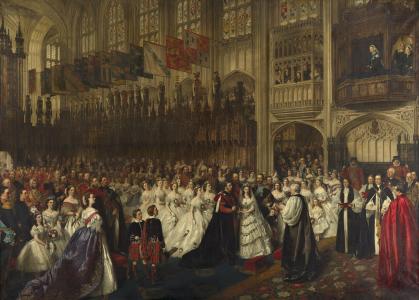 10 Mar 1863. William Powell Frith (age 44). Marriage of the future King Edward VII and Alexandra. The artist has depicted the moment when the Prince (age 21) is about to place the ring on the Princess' (age 18) finger. The two little boys dressed in tartan are Prince Leopold (age 9) and Prince Arthur (age 12), Queen Victoria's youngest sons. At the top right of the painting the Queen (age 43) herself looks down on the ceremony.
10 Mar 1863. William Powell Frith (age 44). Marriage of the future King Edward VII and Alexandra. The artist has depicted the moment when the Prince (age 21) is about to place the ring on the Princess' (age 18) finger. The two little boys dressed in tartan are Prince Leopold (age 9) and Prince Arthur (age 12), Queen Victoria's youngest sons. At the top right of the painting the Queen (age 43) herself looks down on the ceremony.

On 10 Mar 1863 King Edward VII of the United Kingdom (age 21) and Alexandra Glücksburg Queen Consort England (age 18) were married at St George's Chapel, Windsor Castle [Map]. She the daughter of King Christian IX of Denmark (age 44) and Queen Louise Hesse-Kassel of Denmark (age 45). He the son of Prince Albert Saxe Coburg Gotha and Queen Victoria of the United Kingdom (age 43). They were third cousin once removed. She a great x 3 granddaughter of King George II of Great Britain and Ireland. 

Slavery Abolished in the USA
On 18 Dec 1865 the 13th Amendment by which Slavery was abolished was certified by Secretary of State William H. Seward.
Abergele Railway Disaster
On 20 Aug 1868 the Irish Mail train collided with goods wagons. The force of the collision derailed the engine, its tender and the leading guard's van. Two runaway wagons next to the brake van, which carried 50 wooden barrels, holding about 1,700 gallons of paraffin oil caught fire. The engine, tender, guard's van and the first three-passenger carriages were instantly enveloped in dense smoke and flames, which soon spread to the fourth carriage and the front of the leading post office van. This prevented any immediate attempt to rescue the occupants of the first four carriages, who all died.
Henry Maxwell 7th Baron Farnham (age 69) and his wife Anna Frances Esther Stapleton (age 63) were killed.
1873 Wigan Rail Crash
On 03 Aug 1873 a northbound "Tourist Special" excursion train, drawn by two locomotives consisted of twenty-five vehicles by the time it left Crewe, derailed at Wigan, colliding with station buildings, killing thirteen passengers. The train was declared to have been travelling at excessive speed. In the sixteenth coach, the one which derailed, was travelling Florence Sutherland Leveson-Gower (age 18) with her companion Miss Braggs.
Wedding of Prince Alfred and Grand Duchess Maria of Russia
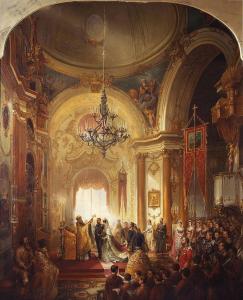 On 23 Jan 1874 Unknown Painter. The Wedding of Prince Alfred Windsor (age 29) and Maria Holstein Gottorp Romanov (age 20).
On 23 Jan 1874 Unknown Painter. The Wedding of Prince Alfred Windsor (age 29) and Maria Holstein Gottorp Romanov (age 20).
On 23 Jan 1874 Prince Alfred Windsor (age 29) and Maria Holstein Gottorp Romanov (age 20) were married. He the son of Prince Albert Saxe Coburg Gotha and Queen Victoria of the United Kingdom (age 54). She a great x 5 granddaughter of King George I of Great Britain and Ireland. 
The Times. 02 Feb 1874. THE MARRIAGE FESTIVITIES IN RUSSIA. ST. PETERSBURIG. Jan 31 Yesterday the Duke (age 29) and Duchess of Edinburgh (age 20), the Prince (age 32) and Princess of Wales (age 29), and Prince Arthur (age 23) were present with all the Imperial family at the ball given by the Cesarewvitch. The Prince of Wales (age 32) wore the uniform of the Norfolk Militia and Prince Arthur (age 23) that of the Rifle Brigade. This evening a grand dinner, to which 400 guests are invited, will be given by the British Ambassador to the Crown Prince and Princess of Germany and Prince Arthur. Later on in the evening all the English Princes will go to the ball given at the Hall of the Nobles at 9:30.
Bunker's Hill Colliery Explosion
30 Apr 1875. The colliery was the property of Messrs. William Rigby and Company with Mr. George Sumner as the manager. An explosion took place at the colliery which claimed the lives of forty men and boys. The colliery was close to the Talk o’ th’ Hill and Bignall Hall Collieries at which there had been previous disasters. Every precaution was taken for the safety of the men and on the morning of the disaster one hundred went to work in the pit including thirty five into the Eight Feet Banbury seam to work about 800 yards from the shaft.
The colliery was the property of Messrs. William Rigby and Company with Mr. George Sumner as the manager. An explosion took place at the colliery which claimed the lives of forty men and boys. The colliery was close to the Talk o’ th’ Hill and Bignall Hall Collieries at which there had been previous disasters. Every precaution was taken for the safety of the men and on the morning of the disaster one hundred went to work in the pit including thirty five into the Eight Feet Banbury seam to work about 800 yards from the shaft.
Those who died: J. Ashmore, C. Baddeley, T. Beech, D. Boston, W. Boughey, J. Boyd, E. Breeze, J. Buckley, G. Burton, J. Carter, J. Chadwick, D. Charlesworth, I. Cooper, R. Dale H .Dean, T. Dean, D. Fox, E. Hancock, J. Hancock, W. Hancock, J. Higgins, G. Holland, J. Holland, T. Holland, R. Jackson, T. Lawton, J. Lucas, J. Marshall, T. Mason, W. Maxwell, H. Moore, W. Moore, S. Morris, J. Nield, T. Peats, W. Proudlove, J. Rogers, J. Stevenson, J. Stubbs, N. Sumner, T. Thompson, J. Yearsley One unnamed.
The inquest into the disaster was opened at the Swan Inn, Talk o’ th’ Hill, by Mr. J. Booth, Coroner. Mr. Wynne, the Inspector made a thorough inspection of the workings and Mr. S.B. Gilroy, Assistant Inspector, thought the mine was well managed but Mr. Wynne commented
For more than twenty years I have been pointing out what a "farce" it is to prohibit the use of naked lights in mines and yet allow powder to be used and have indulged in the hope that self-preservation would prevail over the more idle method of getting coal by blasting but I am now satisfied that the only safe course to take, is to prohibit all explosives in coal mines, and in a few years the coal owners would wonder how they could have allowed their coals to be blow to atoms and the roofs shaken as they have been for many years and the colliers would find that, having got rid of the impure fumes of the powder and dangers of explosions, together with the comparative safety from falls of roof, they were amply repaid for an extra hour of labour the wedging process would entail. Nothing could more clearly show the advantage of wedging over those of powder than to state of the two downbrows of 600 yards each, which effectually withstood the enormous strain which must have been put on them by the force of the air that must have been driven from the seat of the explosion, to the top of the upcast shaft, not so much as a hundredweight of coal was blown down in them or in the dips the slightest degree injured, or indeed was that proportion of the levels which was driven without blasting.
The only reason assigned for the change from wedging to blasting was, that Mr. Rigby could not compete with his neighbours if he wedged the coal and they blasted theirs so that to meet competition he was obliged to increase production and lessen cost.
In the report made by Mr. Dowdswell there was no doubt that the explosion was caused by a shot fired in a thirling on the East side of the engine brow and he was satisfied that there had been no breach of the rules and the fireman had taken all precautions before he fired the shot. It was thought that the method for firing the shots by a touch paper was most dangerous. It was thought that the fireman went to light the fuse and retired to a place which he thought was safe and opened his lamp to light the touch paper and it was thought that the gas came from the floor of the mine.
The jury returned and open verdict and recommended that blasting should be discontinued in all mines in which safety lamps were used. They also recommended that in opening out new workings, the ventilation should be set by bratticing and not by air pipes.
After 30 Apr 1875. All Saints Church, Old Rode. In Memory of Thomas Beech who was killed in the Bunker's Hill Colliery Explosion.
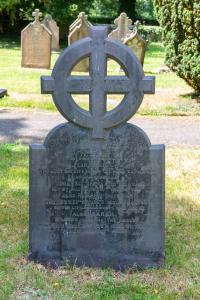
After 30 Apr 1875. All Saints Church, Old Rode. In Memory of Daniel Fox who was killed in the Bunker's Hill Colliery Explosion.
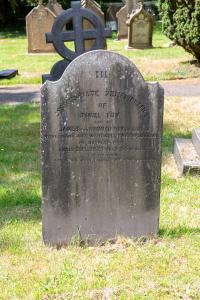
New Years Appointments
Edinburgh Gazette 14 Jan 1876. 14 Jan 1876. Whitehall Palace [Map].
The Queen (age 56) has been pleased to direct Letters Patent to be passed under the Great Seal of the United Kingdom of Great Britain and Ireland, granting the dignities of an Earl and Duke of the said United Kingdom to Charles Henry, Duke of Richmond, K.G. (age 30), and the heirs male of his body lawfully begotten, by the names, styles, and titles of Earl of Kinrara, in the County of Inverness, and Duke of Gordon, of Gordon Castle, in that part of the said United Kingdom called Scotland.

The Queen (age 56) has also been pleased to direct Letters Patent to be passed under the said Great Seal, granting the dignities of an Earl and Marquess of the said United Kingdom to William, Earl of Abergavenny (age 49), and the heirs male of his body lawfully begotten, by the names, styles, and titles of Earl of Lewes, in the County of Sussex, and Marquess of Abergavenny, in the County of Monmonth.

The Queen (age 56) has also been pleased to direct Letters Patent to be passed under the said Great Seal, granting the dignities of a Viscount and Earl of the said United Kingdom to Edward Montagu Stuart Granville, Lord Wharncliffe (age 48), and the heirs male of his body lawfully begotten, by the names, styles, and titles of Viscount Carlton, of Carlton, and Earl of Wharncliffe, bdth in the West Riding of the County of York; with remainder, in default of such issue male, to the Honourable Francis Dudley Stuart-Wortley (age 46) (brother of the said Edward Montagu Stuart Granville, Lord Wharncliffe), and the heirs male of his body lawfully begotten.

The Queen (age 56) has also been pleased to direct Letters Patent to be passed under the said Great Seal, granting the dignity of a Baron of the said United Kingdom to John, Earl of Erne (age 73), in that part of the said United Kingdom called Ireland, K.P., and the heirs male of his body lawfully begotten, by the name, style, and title of Baron Fermanagh, of Lisnaskea, in the County of Fermanagh.
The Queen (age 56) has also been pleased to direct Letters Patent to be passed under the said Great Seal, granting the dignity of a Baron of the said United Kingdom to John Ralph Ormsby-Gore (age 59), Esq, and the heirs male of his body lawfully begotten, by the name, style, and title of Baron Harlech, of Harlech, in the County of Merioneth; with remainder, in default of snch issue male, to William Richard Ormsby-Gore, Esq (age 56). (brother of the said John Ralph Ormsby-Gore), and the heirs male of his body lawfully begotten.
The Queen (age 56) has also been pleased to direct Letters Patent to be passed under the said Great Seal, granting the dignity of a Baron of the said United Kingdom to Henry Gerard Sturt (age 50), Esq, and the heirs male of his body lawfully begotten, by the name, style, and title of Baron Alington, of Crichel, in the County of Dorset.
The Queen (age 56) has also been pleased to direct Letters Patent to be passed under the said Great Seal, granting the dignity of a Baron of the said United Kingdom to John Tollemache, Esq, and the heirs male of his body lawfully begotten, by the name, style, and title of Baron Tollemache, of Helmingham Hall, in the County of Suffolk.
The Queen (age 56) has also been pleased to direct Letters Patent to be passed under the said Great Seal, granting the dignity of a Baron of the said United Kingdom to Sir Robert Tolver Gerard, Bart., and the heirs male of his body lawfully begotten, by the name, style, and title of Baron Gerard, of Bryn, in the County Palatine of Lancaster.
New Years Appointments.
On 14 Jan 1876 ...
William Neville 1st Marquess Abergavenny (age 49) was created 1st Marquess Abergavenny, 1st Earl Lewes. Caroline Vanden Bempte Johnston Marchioness Abergavenny by marriage Marchioness Abergavenny.
Edward Stuart-Wortley-Mackenzie 1st Earl Wharncliffe (age 48) was created 1st Earl Wharncliffe. Susan Charlotte Lascelles Countess Wharncliffe (age 42) by marriage Countess Wharncliffe.

John Ormsby-Gore 1st Baron Harlech (age 59) was created 1st Baron Harlech with remainder to his brother William in the absence of male heirs.
Henry Gerard Sturt 1st Baron Alington (age 50) was created 1st Baron Alington. Augusta Bingham Baroness Alington (age 43) by marriage Baroness Alington.
Abbots Ripton Railway Disaster
On 21 Jan 1876 Herbert Noble (age 19) died in a railway accident at Abbots Ripton. The Special Scotch Express train from Edinburgh to London was involved in a collision, during a blizzard, with a coal train. An express travelling in the other direction then ran into the wreckage.
On 21 Jan 1876 Isabella Williamson (age 42), and her two sons James Charles Allgood (age 13) and David Williamson Allgood (age 11) died in a railway accident at Abbots Ripton.
1878 Double Royal Wedding
On 18 Feb 1878 a double Royal Wedding took place at Berlin. The brides were second-cousins.
Bernhard Saxe Meiningen III Duke Saxe Meiningen (age 26) and Charlotte Hohenzollern (age 17) were married. She the daughter of Frederick III King Prussia (age 46) and Victoria Empress Germany Queen Consort Prussia (age 37). He the son of Georg II Duke of Saxe Meiningen (age 51). She a granddaughter of Queen Victoria of the United Kingdom.
Frederick Augustus II Grand Duke of Oldenburg (age 25) and Elisabeth Anna Hohenzollern (age 21) were married. He a great x 5 grandson of King George I of Great Britain and Ireland. She a great x 5 granddaughter of King George I of Great Britain and Ireland.
The event was attended by King Leopold II of Belgium (age 42) and his wife Marie Henriette of Austria, and the Prince of Wales (age 36) and his brother Prince Arthur Windsor 1st Duke Connaught and Strathearn (age 27).
Disappearance of HMS Atalanta
On 31 Jan 1880 HMS Atlanta, serving as a training ship, set sail from the Royal Naval Dockyard in Bermuda for Falmouth, England. It was presumed that she sank in a powerful storm which crossed her route a couple of weeks after she sailed. The search for evidence of her fate attracted worldwide attention, and the Admiralty received more than 150 telegrams and 200 personal calls from anxious friends and relatives after it was announced that the ship was missing, and possibly lost.
Philip Ernest Fisher (age 22) was presumed drowned.
Assassination of Tsar Alexander II
On 13 Mar 1881 Tsar Alexander II of Russia (age 62) was assassinated. He died at the Winter's Palace, St Petersburg. His son Tsar Alexander III of Russia (age 36) succeeded III Tsar Russia. Dagmar aka Maria Feodrovna Glücksburg (age 33) by marriage Tsarina Russia.
As he was known to do every Sunday for many years, the emperor went to the Mikhailovsky Manège for the military roll call. A young member of the Narodnaya Volya ("People's Will") movement, Nikolai Rysakov, threw a bomb which explosion Alexander survived. A second young member of the Narodnaya Volya, Ignacy Hryniewiecki, threw a second bomb killing the Tsar.
First Electric Lighting
On 19 Jan 1883 the first standardized incandescent electric lighting system employing overhead wires began service in Roselle, New Jersey. It had been built by Thomas Edison to demonstrate that an entire community could be illuminated by electricity.
Double Heese Darmstadt Marriage
On 30 Apr 1884 father and daughter, Prince Louis Hesse Darmstadt IV Grand Duke (age 46) and Victoria Hesse Darmstadt Marchioness Milford Haven (age 21), were both married on the same, of near, days, he taking advantage pf his relatives being in Darmstadt for his daughter's wedding. He, apparently, didn't approve of his daughter's choice of his first cousin Prince Louis of Battenburg 1st Marquess Milford Haven (age 29) since they, Prince Louis of Battenburg 1st Marquess Milford Haven (age 29) and Victoria Hesse Darmstadt Marchioness Milford Haven (age 21) would live in Britain.
Prince Louis of Battenburg 1st Marquess Milford Haven (age 29) and Victoria Hesse Darmstadt Marchioness Milford Haven (age 21) were married. She the daughter of Prince Louis Hesse Darmstadt IV Grand Duke (age 46) and Princess Alice Saxe Coburg Gotha. They were first cousin once removed. She a granddaughter of Queen Victoria of the United Kingdom.
In the evening Prince Louis Hesse Darmstadt IV Grand Duke (age 46) and Alexandrina Hutten Czapska (age 29) were married. She being his former mistress. Apparently, they separated within a week and the marriage was annulled within three months.
Margaret Pole Beatified
On 29 Dec 1886 Margaret York Countess of Salisbury was beatified as a martyr by Pope Leo XIII.
Vincent Van Gogh Cuts his Ear Off
On 23 Dec 1888 Vincent van Gogh severed his left ear with a razor. He bandaged the wound, wrapped the ear in paper, and delivered the package to a woman at a brothel he and Gauguin both frequented.
Birth of King George VI
On 14 Dec 1895 King George VI of the United Kingdom was born to George V King United Kingdom (age 30) and Victoria Mary Teck Queen Consort England (age 28) at York Cottage, Sandringham Estate. The second son at birth he became King when his elder brother King Edward VIII of the United Kingdom (age 1) Abdicated. Coefficient of inbreeding 1.84%.
1889 Cleveland Street Scandal
The 1889 Cleveland Street Scandal was the discovery of a male brothel on Cleveland Street in London by the police. Those working at the brothel named a number of the nobility leading to accusations that the government were attempting a cover up ...
1897 Devonshire House Ball
 1897. Henry van der Weyde (age 59). Photograph of Ernest William Beckett 2nd Baron Grimthorpe (age 40) as "Sir Walter Raeligh" at the 1897 Devonshire House Ball.
1897. Henry van der Weyde (age 59). Photograph of Ernest William Beckett 2nd Baron Grimthorpe (age 40) as "Sir Walter Raeligh" at the 1897 Devonshire House Ball.
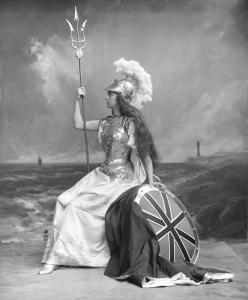 1897. James Lafayette (age 44). Photograph of Edith Amelia Ward Baroness Wolverton (age 24) as "Brittania" at the 1897 Devonshire House Ball.
1897. James Lafayette (age 44). Photograph of Edith Amelia Ward Baroness Wolverton (age 24) as "Brittania" at the 1897 Devonshire House Ball.
Edith Amelia Ward Baroness Wolverton: On 16 Sep 1872 she was born to William Ward 1st Earl of Dudley and Georgina Moncrieffe Countess Dudley. On 05 Jan 1895 Frederic Glyn 4th Baron Wolverton and she were married. She by marriage Baroness Wolverton. She the daughter of William Ward 1st Earl of Dudley and Georgina Moncrieffe Countess Dudley. On 06 Jun 1956 Edith Amelia Ward Baroness Wolverton died.
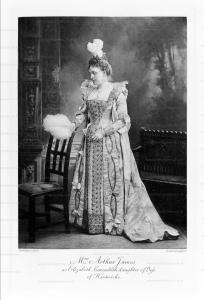 02 Jul 1897. Henry Bullingham (age 45). Photograph of Mary Venetia Cavendish-Bentinck (age 36) at the Devonshire House Ball as Elizabeth Cavendish daughter of Bess of Hardwick.
02 Jul 1897. Henry Bullingham (age 45). Photograph of Mary Venetia Cavendish-Bentinck (age 36) at the Devonshire House Ball as Elizabeth Cavendish daughter of Bess of Hardwick.

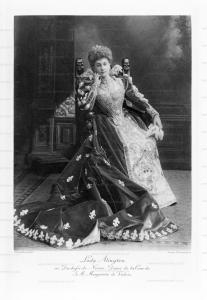 02 Jul 1897. Henry Bullingham (age 45). Photograph of Evelyn Henrietta Leigh Baroness Alington at the Devonshire House Ball as Duchesse de Nevers, Dame de la Cour de S.M. Marguérite de Valois.
02 Jul 1897. Henry Bullingham (age 45). Photograph of Evelyn Henrietta Leigh Baroness Alington at the Devonshire House Ball as Duchesse de Nevers, Dame de la Cour de S.M. Marguérite de Valois.
Evelyn Henrietta Leigh Baroness Alington: she was born to Henry Blundell Leigh. On 10 Feb 1892 Henry Gerard Sturt 1st Baron Alington and she were married. She by marriage Baroness Alington. On 23 Jan 1939 she died.
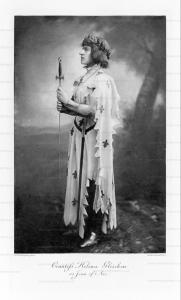 02 Jul 1897. Henry Bullingham (age 45). Photograph of Helena Gleichen (age 24) at the Devonshire House Ball as Joan of Arc.
02 Jul 1897. Henry Bullingham (age 45). Photograph of Helena Gleichen (age 24) at the Devonshire House Ball as Joan of Arc.
Helena Gleichen:
On 01 Feb 1873 she was born to Prince Victor of Hohenlohe Langenburg Count Gleichen and Princess Laura Williamina Seymour. On 28 Jan 1947 she died.
On 28 Jan 1947 she died.
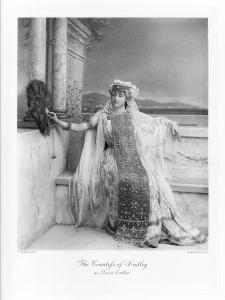 02 Jul 1897. Henry Bullingham (age 45). Photograph of Rachel Anne Gurney Countess Dudley (age 29) at the Devonshire House Ball as Queen Esther.
02 Jul 1897. Henry Bullingham (age 45). Photograph of Rachel Anne Gurney Countess Dudley (age 29) at the Devonshire House Ball as Queen Esther.
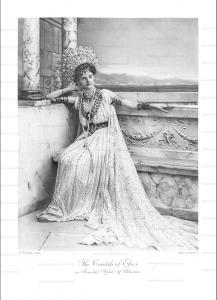 02 Jul 1897. Henry Bullingham (age 45). Photograph of Adele Beach Grant Countess Essex (age 30) at the Devonshire House Ball as Bernice Queen of Palestine.
02 Jul 1897. Henry Bullingham (age 45). Photograph of Adele Beach Grant Countess Essex (age 30) at the Devonshire House Ball as Bernice Queen of Palestine.
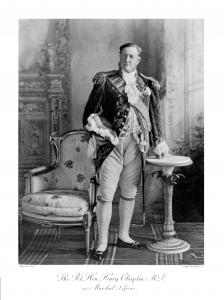 12 Jul 1897. James Lafayette (age 44). Photograph of Henry Chaplin 1st Viscount Chaplin (age 56) as "Marshal Lefevre" at the 1897 Devonshire House Ball.
12 Jul 1897. James Lafayette (age 44). Photograph of Henry Chaplin 1st Viscount Chaplin (age 56) as "Marshal Lefevre" at the 1897 Devonshire House Ball.
Second Boer War
Siege of Mafeking
On 31 Oct 1899 Douglas Henry Marsham (age 28) was killed.